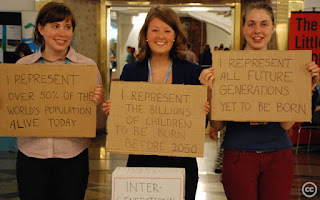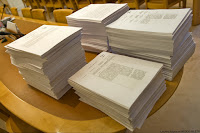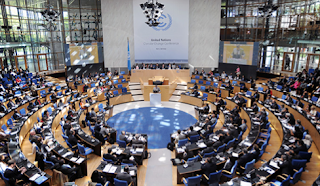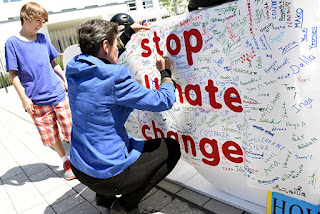Fwd: The Great Change
3 views
Skip to first unread message
Charley Quinton
Jun 7, 2015, 7:08:47 PM6/7/15
to Toby and Debby Dulworth, Deb Deworth, coal...@googlegroups.com
I hope we're still around for this. Some good information here. I would sure love to get back to work.
http://cotw.cc/wiki/User:Tractor
---------- Forwarded message ----------
From: The Great Change <noreply+...@google.com>
Date: Sun, Jun 7, 2015 at 2:18 PM
Subject: The Great Change
To: charley...@gmail.com
From: The Great Change <noreply+...@google.com>
Date: Sun, Jun 7, 2015 at 2:18 PM
Subject: The Great Change
To: charley...@gmail.com
The Great Change |
|
Posted: 07 Jun 2015 07:06 AM PDT "These talks are not just about streamlining a text; they are about realizing, at a deeper level, the scope of the problem and the required scale for any response."
 Newspaper reporting legend Ross Gelbspan once said, lifestyle change is essential, but lifestyle change won't get us out of this climate mess. We need change of the kind that only comes from governments, acting together. Newspaper reporting legend Ross Gelbspan once said, lifestyle change is essential, but lifestyle change won't get us out of this climate mess. We need change of the kind that only comes from governments, acting together.In a larger sense, we need a change of the kind that defies the arc of social history extending back to at least the last Ice Age. Let's face it. Our civilizations are built on organized murder, slavery and rape of the natural world and of each other. We are a nasty bit of work, we naked apes. Some of us work towards change at this very cellular level, exploring spiritual and social limitations, working on our group dynamics, getting under our skin with art, music and spoken word, encouraging the heathen masses to break free from our serpent nature and rise up. There has always been a tension between "bottom up" grass roots organizing and "top-down" working for policy changes from the infrastructural brain centers. Most political activists do both, although some will not compromise, on principle, and so fail to even get inside the buildings where decisions are taken. Others, like the Green Party activists in Germany, Ireland and elsewhere, succeed in winning seats in government only to see their aspirations dashed in the reakpolitik of consensus governance. A study by Professors Martin Gilens and Benjamin Page published last fall in Perspectives on Politics challenged the commonly held belief -- the story children in Western countries are routinely taught in school -- that the way democracies work is by electoral, pluralistic expressions of public opinion.
Multivariate analysis indicates that economic elites and organized groups representing business interests have substantial independent impacts on U.S. government policy, while average citizens and mass-based interest groups have little or no independent influence. The results provide substantial support for theories of Economic-Elite Domination and for theories of Biased Pluralism, but not for theories of Majoritarian Electoral Democracy or Majoritarian Pluralism. -- Gilens and Page Welcome to Bonn  Climate change talks rekindled this week in Bonn where representatives from 195 countries are drafting the final negotiating text of the climate change agreement – now at 4232 lines and 89 pages. Whatever is arrived at will become the next-to-last version for the legally binding treaty that will be signed in Paris this December. Heads of State will be in Paris to pass around flutes of sparkling wine and hors-d'œuvre of sausage paté. Bonn is where the sausage is being stuffed before being hung to cure. Climate change talks rekindled this week in Bonn where representatives from 195 countries are drafting the final negotiating text of the climate change agreement – now at 4232 lines and 89 pages. Whatever is arrived at will become the next-to-last version for the legally binding treaty that will be signed in Paris this December. Heads of State will be in Paris to pass around flutes of sparkling wine and hors-d'œuvre of sausage paté. Bonn is where the sausage is being stuffed before being hung to cure.The 21st annual meeting of the parties to the UN Convention on Climate Change (COP21) carries high expectations. Delegates in Bonn are feeling the pressure of disappearing time to finalize the negotiating text and to ensure the new agreement will be legally binding, anchored by honest science, and acceptable to all parties. It is a tall order, but after all, it has been 20 years in the making, so they are not fresh to the process.  The expected draft will likely encourage a massive expansion of renewable energy, greatly improved energy efficiency, a shifting of subsidies from fossil fuels to renewables, a renewed focus on sustainable agricultural practices, and research initiatives to develop zero carbon and net-sequestering infrastructures for all aspects of industrial civilization. The expected draft will likely encourage a massive expansion of renewable energy, greatly improved energy efficiency, a shifting of subsidies from fossil fuels to renewables, a renewed focus on sustainable agricultural practices, and research initiatives to develop zero carbon and net-sequestering infrastructures for all aspects of industrial civilization. To facilitate that historic switch, overdeveloped country financial support to underdeveloping countries will be essential. Conventional wisdom would have it that support should come in the forms of technology and capacity building, paid through finance mechanisms only vaguely defined, which is to say, voluntary, self-imposed targets that are neither economically painful nor especially quick.  At the prior prep meeting in Geneva, the draft treaty called for regular periodic meetings to set collective finance targets, with separate targets for mitigation and adaptation, based on ascertaining support requirements of the underdeveloping world. At the prior prep meeting in Geneva, the draft treaty called for regular periodic meetings to set collective finance targets, with separate targets for mitigation and adaptation, based on ascertaining support requirements of the underdeveloping world. It is key that the Paris treaty include phasing out fossil fuel emissions. To those working in the sausage factory that means phasing in 100% renewable energy, but the Bonn delegates seem a bit deluded in imagining that the old and new are roughly equivalent and we simply have to sweep out those smelly oily rags and uncrate that shiny new solary stuff. Making pig iron—the main ingredient in steel—requires blast furnaces. Making cement requires 100-meter-long kilns that operate at 1500 degrees C. In principle it is possible to produce high heat for these purposes with electricity or giant solar collectors, but nobody does it that way now because it would be much more expensive than burning coal or natural gas. Crucially, current manufacturing processes for building solar panels and wind turbines also depend upon high-temperature industrial processes fueled by oil, coal, and natural gas. Again, alternative ways of producing this heat are feasible in principle—but the result would probably be significantly higher-cost solar and wind power. And there are no demonstration projects to show us just how easy or hard this would be. -- Richard Heinberg, Renewable Energy Will Not Support Economic Growth Killing Nessie Euen Mears observes in his May 22 post, The Loch Ness Monster of Energy Storage, that the intermittency of many solar-based renewables places large requirements for storage on a system that has neither the present technology nor any reckoning of the cost. Mears dissected Scotland's plan to build a gigantic pumped storage hydro scheme, Strath Dearn, in the Monadhliath Mountains, just south of Inverness (population 72,000) on the upper reaches of the River Findhorn. The scheme proposes to pump seawater from a location on the Moray Firth just east of Inverness to an elevation of about 300 m above sea level from where the water will flow south along a canal to the base of dam at an elevation of about 350 m where it is pumped into a reservoir with maximum surface elevation of 650 m. At one level, this is a standard pumped hydro storage scheme employing the sea as the lower reservoir. The scheme would have two pumping and generating stations, one by the sea and the other at the base of the dam. Untoward side effects: Loch Ness will become salty from seawater migration. Tectonic stresses caused by loading and unloading the site with 4.4 billion tons of water on a regular basis make living below the dam a risky proposition. Moreover, Mears calculates that storage on the order 472 GWh would be required to span low-wind lulls, given present Northern Scottish power demand and zero population growth. Scaling to a 100% wind-pumped-storage system would increase the planned, already gigantic offshore wind farm from 3 GW to 50 GW. The storage requirement then grows to 50/3*472GWh = 7867 GWh. At that size the proposed reservoir site is not large enough to guarantee uninterrupted supply. So do they power the pumps with coal? Nuclear? Fracked gas?  Which brings up the first of two problems with a UN plan to replace fossil with renewables. Fossil energy is all about converting caloric content of dead dinosaurs to boil water or otherwise make mechanical or electrical power. Renewables like solar thermal and biomass may work that way, but wind and photovoltaics do not. Fossil energy is the stored sunlight of 500 million years – a great big savings account of light striking some part of our planet for half of each day. Renewables are more like a checking account, we get to use them as they arrive, but savings are pretty much out of the picture. Which brings up the first of two problems with a UN plan to replace fossil with renewables. Fossil energy is all about converting caloric content of dead dinosaurs to boil water or otherwise make mechanical or electrical power. Renewables like solar thermal and biomass may work that way, but wind and photovoltaics do not. Fossil energy is the stored sunlight of 500 million years – a great big savings account of light striking some part of our planet for half of each day. Renewables are more like a checking account, we get to use them as they arrive, but savings are pretty much out of the picture. "Nothing says bathroom break better than a 40-foot plastic Brontosaurus." – Larry the Cable Guy The second difference is EROIE, or energy return on invested energy. Fossil fuels are very energy dense. A cup of gasoline can take a 2-ton truck over a mountain. How many horses would have to be fed how much grain to accomplish the same task? How many hours of wind generators charging batteries? Sunlight is very distributed and most of it falls on the ocean. Sure, solar input is nearly 4 million exajoules per year, versus only 550 exajoules from all fossil fuel burned to date, but as Charles A.S. Hall, who invented the EROIE concept, says, it is naïve in his opinion, "that we can replace fossil fuels with biofuels (most of which have little or no net yield), efficiency, and solar power."
-- Bioscience 65:6:624 (2015)  Bonn NGOs such as Climate Action Network have called for provisions in the treaty that guarantee sustainable energy for all. By all, do they mean 8 billion people? 12 billion? More? Where do they think that much energy will come from? Bonn NGOs such as Climate Action Network have called for provisions in the treaty that guarantee sustainable energy for all. By all, do they mean 8 billion people? 12 billion? More? Where do they think that much energy will come from?Of the countless new initiatives being announced, some are good, and some (let’s face it) are greenwashing. – Climate Action Network  Just take food supply, for instance. To bring the climate back in line will require restoring normal carbon and nitrogen flows, and to accomplish that we will need to do what Wendell Berry and Wes Jackson have been recommending – change from a mix of 80% annuals and 20% perennials to the reverse ratio. Tree crops have a lot in common with other forms of renewable energy, because their production is less dense – requiring more land per food calorie produced, although the ecological services produced by forests are incalculable. Just take food supply, for instance. To bring the climate back in line will require restoring normal carbon and nitrogen flows, and to accomplish that we will need to do what Wendell Berry and Wes Jackson have been recommending – change from a mix of 80% annuals and 20% perennials to the reverse ratio. Tree crops have a lot in common with other forms of renewable energy, because their production is less dense – requiring more land per food calorie produced, although the ecological services produced by forests are incalculable. Over 35% of the energy in agriculture is used making nitrogen fertilizers. If this must drop by 90%, as I believe it must, that means creating an agriculture dependent on the cycling of all nutrients, including human waste. It also means having a lot more farmers, at least 10 times as many as at present, perhaps more like 20 times, and all of us will need to live closer to the land that feeds us. Compensating Loss For the 2015 agreement to be successful, there needs to be stronger recognition that the effects of climate change will necessitate increased adaptation, away from the memes of "make it happen" industrial civilization and towards the memes of harmony with natural cycles and flows. In Bonn, as in Paris, that discussion is not being had. Instead delegates are trying anchor the Warsaw mechanism on loss and damage and ensure additional finance. "Loss and damage" places a burden on polluters to compensate those most injured by climate change, on the theory that such a policy will put a tangible price on pollution that can begin to value carbon and change the pass-through pollution paradigm for global business and finance. We can foresee problems with the loss and damage approach. So, for instance, who will the US government more likely compensate for loss from climate change, almond farmers in California or drought refugees in Yemen? Apply that same logic for all nations. These Bonn talks are critical, not just in shaping the Paris agreement, but also in achieving a common understanding on a range of important issues. These talks are not just about streamlining a text; they are about realizing, at a deeper level, the scope of the problem and the required scale for any response. This is the first of two parts, to be continued next week. |
| You are subscribed to email updates from The Great Change
To stop receiving these emails, you may unsubscribe now. |
Email delivery powered by Google |
| Google Inc., 1600 Amphitheatre Parkway, Mountain View, CA 94043, United States | |
--
Reply all
Reply to author
Forward
0 new messages



